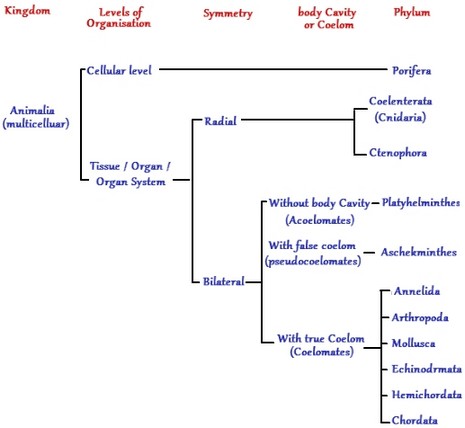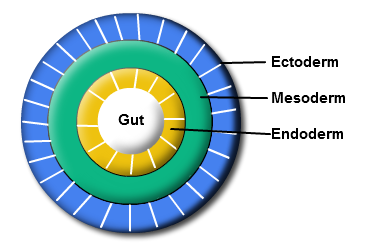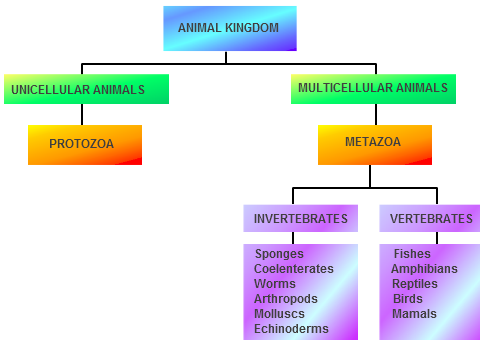


 النبات
النبات
 الحيوان
الحيوان
 الأحياء المجهرية
الأحياء المجهرية
 علم الأمراض
علم الأمراض
 التقانة الإحيائية
التقانة الإحيائية
 التقنية الحيوية المكروبية
التقنية الحيوية المكروبية
 التقنية الحياتية النانوية
التقنية الحياتية النانوية
 علم الأجنة
علم الأجنة
 الأحياء الجزيئي
الأحياء الجزيئي
 علم وظائف الأعضاء
علم وظائف الأعضاء
 الغدد
الغدد
 المضادات الحيوية
المضادات الحيوية|
Read More
Date: 28-10-2015
Date: 30-10-2015
Date: 5-11-2015
|
Animal Kingdom Classification
Animals are characterized being multicellular and eukaryotic. Classification of animals is about organizing organisms into groups. Members of a group have shared characteristic, that is common to all members of that group and it is this character that defines the group.
There are about 1.2 million species of animals identified and there are almost 9-10 million species of animals on earth. This huge population of animals creates importance for the need of classification. Classification helps in assigning a systematic position to newly described species.

Characteristics of Animal Kingdom Classification
Basis of Classification
There is a difference in structure and form of different animals, there are a few fundamental characteristics that are common to various organisms. The features are
Levels of Organization
All the organisms of the Animal kingdom are multicellular but they do not exhibit the same pattern if organization of cells.
The patterns of cellular organization seen in animals are:

Patterns of Organ Systems
Organs systems in different groups of animals exhibit various patterns of complexities.
Incomplete digestive system - This pattern of digestive has only one opening to the outside of the body, i.e., a single opening serves as both mouth and anus. Example: Platyhelminthes.
Complete digestive system - In this pattern there are two opening to the outside of the body, the mouth and the anus. Example: Arthropods, Chordates, etc.
Open type - In open type circulatory system the blood is pumped out of the heart and the cells and tissues are diectly bathed in it.
Closed type - In this type of circulatory system the blood is circulated through a series of vessels of varying diameters - the arteries, veins and capillaries.
Body Symmetry
Animals can be categorized on the basis of their body symmetry. The arrangement of body parts around a central point or line determines the symmetry.

Body Wall
Body wall of animals are arranged in two or three embryonic layers. Accordingly animals are diplobalstic or triploblastic.


Nature of Coelom
The presence or absence of a cavity between the body wall and the gut wall is important characteristic for classification. Coelom is the body cavity that is lined by the mesoderm. There are three types of animals based on the type of coelom - coelomates, pseudocoelomates or acoelomates.

Segmentation
In some animals, body is segmented externally and internally, with serial repittion of at least some organs. This phenomenon is known as metamerism and the segmented body pattern is known as metameric segmentation. Example: Earthworm.
Notochord
In some animals during embryonic development, a mesodermally derived rod-like structure is formed on the dorsal side, this is known as notochord. Animals with notochord are known as chordates and the animals which do not form notochord are known as non-chordates. Example: Porifera to Echinoderms.
Animal Kingdom Classification System
There are many different types of animals which are similar and different to each other in many aspects. Members of a particular group of animal share a particular characteristic that is common to all the members of the group. This is the feature that defines the group.
Biologists arrange organisms into groups on the basis of traits which they share with other animals and the genetic relationship with each other. This orderly form of classification of animals is the basis of taxonomy. Modern taxonomy is based on physical characteristics and genetic characteristics. Systematics is the field of study that focuses on evolutionary relationships between living organisms.
Carlous Linnaeus (1707-1778), a Swedish botanist was the inventor of modern scientific classification. He designed his system of classification so that each animal and plant he described had only one name and this name would not be shard with any other organism.
The system most scientist use put each living thing into seven groups or taxons. They are organized from most general to most specific category. These categories in the hierarchical system are from higher and most inclusive to lower to more specific are kingdom, phylum, class, order, family, genus and species.

Kingdom is the highest primary division in which all objects are placed. All animals are part of the Animal Kingdom.
Phylum - Each kingdom is divided into smaller units called phyla. Example, chordates are a phylum with members possessing the nerve cord.
Class - The chordates are further divided into classes such as Mammalia, Birds, Reptilia, Amphibians. Members of each class have a characteristics that they share with the members of the same class but are not found in members of other classes.
Family - Classes are further divided into families. Families contain more than one genus.
Genus - Families are sub-divided into genera. Animals that share the same genus are very similar and probably evolved from the same common ancestor.
Species - Species is the most fundamental and contains single type of animal.
Animal Kingdom Classification Chart

Animals are classified into two principal groups invertebrates (with-out backbone) and vertebrates (with backbone). Backbone is the observable feature which defines whether the animal is vertebrate or invertebrate.
Sponges, star fish, Obelia, worms, spiders, insects are the sub-groups of the invertebrate group, they do not have a backbone.
Fishes, birds, frogs, snakes and mammals have a backbone and are the sub-group of the vertebrate group.
References
http://biology.tutorvista.com/organism/animal-kingdom-classification.html



|
|
|
|
"عادة ليلية" قد تكون المفتاح للوقاية من الخرف
|
|
|
|
|
|
|
ممتص الصدمات: طريقة عمله وأهميته وأبرز علامات تلفه
|
|
|
|
|
|
|
الأمين العام للعتبة العسكرية المقدسة يستقبل شيوخ ووجهاء عشيرة البو بدري في مدينة سامراء
|
|
|